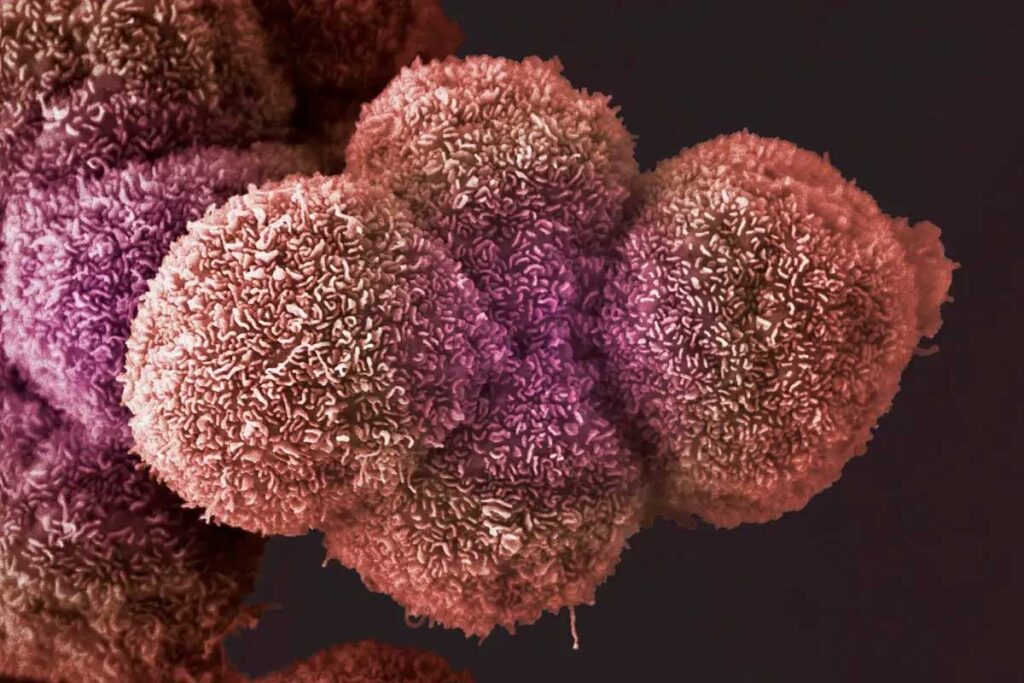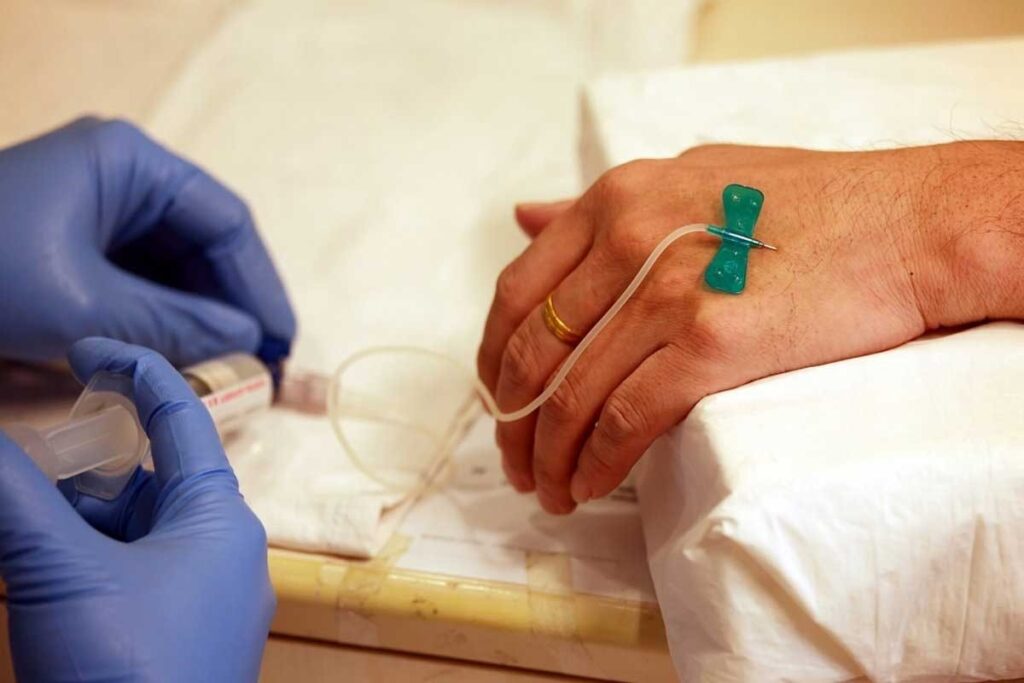Last Updated on October 21, 2025 by mcelik

Cancer is a big health problem all over the world. It affects many people in different ways with various tumor types.
More than 100 types of cancer exist. Each one has its own special features and starts in different cells. These cells are found in different parts of the body.
It’s very important to know about all the kinds of cancer. This knowledge helps doctors find better treatments and also helps improve patient outcomes.
Liv Hospital focuses on the patient. They offer top-notch care and the newest medical knowledge about cancer types.

Cancer is when cells grow out of control and can be deadly. It’s a complex disease that affects many cell types. This makes it hard to diagnose and treat.
To get cancer, you need to know what it is and how it starts.
Cancer is when cells grow without control and can spread. This happens because of genetic changes that mess up cell control.
The main traits of cancer cells are:
Cancer starts with genetic changes that turn normal cells into cancer cells. These changes can come from many things, like the environment, genes, or DNA mistakes.
The steps to cancer are:
| Stage | Description |
| Initiation | A genetic mutation starts, which might lead to cancer |
| Promotion | Mutated cells start to grow and divide more |
| Progression | Cancer cells get more mutations, becoming more aggressive |
| Metastasis | Cancer cells spread to other parts of the body |
Knowing these steps helps us find better ways to treat cancer and help patients.

Cancer is not just one disease but over 100 different conditions. Each one needs its own approach. Understanding the many types of cancer is key to fighting this complex disease.
Cancer can start in almost any part of the body. It’s classified by the cell or organ affected.
The main groups of cancer are carcinomas, sarcomas, and hematologic malignancies. Each group has its own type of cancer cell and origin.
There are several ways to classify cancer. Histological classification looks at tumor cells under a microscope. Molecular classification examines the genetic changes in cancer cells. Knowing these helps doctors plan treatments.
Classifying cancer helps doctors understand its outlook and choose the best treatment. Some cancers are aggressive and need quick action. Others may have a better chance of recovery.
Understanding the diversity of cancer types and how they’re classified helps doctors give better care. This knowledge also leads to new treatments for specific cancers.
The main types of cancer tumors are carcinomas, sarcomas, and hematologic malignancies. Each type has its own features and comes from different tissues.
Carcinomas are the most common cancers. They start from epithelial cells, which cover the surfaces and cavities of organs. These cancers can happen in many parts of the body, like the skin, breast, lung, colon, and prostate.
Examples of carcinomas include:
Sarcomas start from connective tissues. These tissues support and connect all other tissues and organs. They can occur in bone, cartilage, fat, blood vessels, and other supporting tissues.
Types of sarcomas include:
Hematologic malignancies affect the blood, bone marrow, and lymphatic system. They disrupt the normal production of blood cells, causing health problems.
Examples include:
There are also other, less common types of tumors and masses. These include germ cell tumors and neuroendocrine tumors. Each type has its own characteristics and needs specific treatments.
| Cancer Type | Tissue Origin | Examples |
| Carcinomas | Epithelial cells | Adenocarcinoma, Squamous cell carcinoma |
| Sarcomas | Connective tissues | Osteosarcoma, Liposarcoma |
| Hematologic Malignancies | Blood and lymphatic system | Leukemia, Lymphoma |
The most common cancers worldwide have a big impact on health. They are not just common because they happen a lot. They also have a big effect on how long people live and on healthcare systems around the world.
Breast cancer is the most common cancer in women worldwide. It is a big health issue because it happens a lot. Early detection through screening can help people live longer. Things like genetics, lifestyle, and the environment can increase the risk of getting breast cancer.
Lung cancer is a very common and deadly cancer worldwide. It is mainly caused by smoking, but it can also affect non-smokers. It is often found late, making treatment hard. There are two main types of lung cancer, each needing different treatments.
Colorectal cancer is a leading cause of death worldwide. It affects the colon or rectum. Risk factors include age, family history, and lifestyle. Screening tests can find colorectal cancer early, helping with treatment. Removing precancerous polyps during screening can prevent or delay the disease.
Prostate cancer is common in older men. It can grow slowly or quickly, needing different treatments. Prostate-specific antigen (PSA) testing is used for screening, but its benefits and risks are debated. Treatment options include watching the cancer, surgery, or radiation, depending on the cancer and the patient’s health.
Knowing about these common cancers is key to improving prevention and treatment. By focusing on the most common cancers, healthcare can better use resources and help patients more.
Malignancies of the gastrointestinal tract, including pancreatic and liver cancers, are a major health concern. These cancers affect different parts of the digestive system. Each has its own clinical features and challenges.
Pancreatic cancer is hard to diagnose early, leading to a poor prognosis. Symptoms like abdominal pain and weight loss are common but often mistaken for other conditions.
“The late diagnosis of pancreatic cancer is a significant factor in its high mortality rate,” experts say. Better diagnostic techniques are needed to improve outcomes.
Liver cancer is linked to liver disease, such as cirrhosis or hepatitis B and C infections. Risk factors include chronic alcohol use and toxin exposure. Liver cancer can be primary or metastatic, with metastatic being more common.
Managing liver cancer requires a team effort, including surgery and targeted treatments. Prevention through vaccination against hepatitis B and reducing alcohol use can lower the risk.
Esophageal cancer has a high mortality rate and is often diagnosed late. Risk factors include GERD, obesity, and smoking. Early symptoms include dysphagia and weight loss.
Treatment for esophageal cancer depends on the stage. It may include surgery, chemotherapy, and radiation. Screening high-risk populations is key to early detection.
Gallbladder cancer is rare but has a poor prognosis due to late diagnosis. Risk factors include gallstones and chronic inflammation. Surgical removal of the gallbladder is a treatment option for early-stage disease.
The symptoms of gallbladder cancer can be nonspecific, making early diagnosis hard. Knowing the risk factors and symptoms is vital for timely treatment.
It’s important to know about cancers in the reproductive and urinary systems. This knowledge helps with early detection and treatment. These cancers include ovarian, cervical, testicular, and bladder cancers. Each has its own risk factors and symptoms.
Ovarian cancer starts in the ovaries and is common in women. Risk factors include family history, genetic mutations like BRCA1 and BRCA2, and age. Symptoms can be hard to spot early.
Early signs might be bloating and abdominal pain. Doctors use imaging and biopsies for diagnosis. Treatment options are surgery, chemotherapy, and targeted therapy.
Cervical cancer happens in the cervix and is linked to HPV. Regular Pap smears have lowered its incidence and death rate. Risk factors include early sex, many partners, and smoking.
HPV vaccination is key for prevention. Treatment varies by stage and may include surgery, radiation, and chemotherapy.
Testicular cancer is common in young men and starts in the testicles. Risk factors include undescended testes and family history. Symptoms include a painless lump or swelling in the testicles.
Checking yourself is important for early detection. Treatment usually involves surgery, with chemotherapy or radiation added based on the cancer’s stage and type.
Bladder cancer affects the bladder lining and is more common in men. Risk factors include smoking, chemical exposure, and chronic bladder infections. Symptoms include blood in the urine.
Early detection is key for effective treatment. Treatment options include surgery, intravesical therapy, chemotherapy, and radiation, based on the cancer’s stage and grade.
Cancers starting with L are diverse, each with its own traits and treatment plans. They can affect different parts of the body. This makes each cancer unique in its own way.
Leukemia is a blood and bone marrow cancer. It’s caused by too many bad white blood cells. There are several types, including:
Lymphoma is a cancer of the immune system’s lymphatic system. It has two main types: Hodgkin lymphoma and non-Hodgkin lymphoma.
| Type | Description | Common Symptoms |
| Hodgkin Lymphoma | Has Reed-Sternberg cells. | Painless lymph node swelling, fever, night sweats. |
| Non-Hodgkin Lymphoma | A wide range of lymphomas without Reed-Sternberg cells. | Swollen lymph nodes, fever, weight loss. |
Laryngeal cancer is in the larynx, or voice box. It’s more common in men and linked to smoking and drinking.
Liver cancer, or hepatocellular carcinoma, is a primary liver cancer. It’s often linked to chronic liver disease and cirrhosis.
Early detection is key for effective treatment. This can include surgery, ablation therapy, or targeted therapy.
Cancers starting with P, like pancreatic and prostate cancer, are very important. They have different causes, signs, and treatments.
Pancreatic cancer is very aggressive and often found late. It starts in the pancreas, which helps digest food and control sugar levels. Smoking, being overweight, and family history are risk factors.
Symptoms: Symptoms include stomach pain, losing weight, and yellowing of the skin.
Prostate cancer is in the prostate gland of men. It’s a common cancer in older men. A blood test for PSA is used to find it.
Risk Factors: Being older, having a family history, and certain ethnicities increase risk.
Pharyngeal cancer is in the throat. It’s divided into three types: nasopharyngeal, oropharyngeal, and hypopharyngeal. Each has its own risk factors and symptoms.
HPV infection is a big risk for oropharyngeal cancers.
Penile cancer is rare and affects the penis skin. It’s more common in uncircumcised men and those with poor hygiene. HPV infection also increases risk.
Symptoms: Symptoms include thickening or sores on the penis skin.
| Cancer Type | Common Symptoms | Major Risk Factors |
| Pancreatic Cancer | Abdominal pain, weight loss, jaundice | Smoking, obesity, family history |
| Prostate Cancer | Urinary difficulties, pelvic pain | Age, family history, ethnicity |
| Pharyngeal Cancer | Sore throat, difficulty swallowing | HPV infection, smoking, alcohol use |
| Penile Cancer | Changes in penile skin, sores | HPV infection, poor hygiene, uncircumcised |
Cancers starting with P are diverse and challenging. Knowing these differences helps in better diagnosis and treatment.
“The diversity in cancers starting with P shows we need personalized care.”
Skin and soft tissue cancers are a mix of different tumors. They come from various cells and tissues. This leads to many types of cancers.
Melanoma is a fast-growing skin cancer. It starts in cells that make skin color. It can spread quickly to other parts of the body. Finding it early is key to treating it well.
Key Statistics on Melanoma:
| Year | Estimated New Cases | Estimated Deaths |
| 2022 | 99,780 | 7,650 |
| 2023 | 106,110 | 7,180 |
Basal cell carcinoma (BCC) is the most common skin cancer. It shows up on sun-exposed areas. It grows slowly but can damage the area if not treated.
Squamous cell carcinoma (SCC) is another common skin cancer. It comes from squamous cells. It can spread more than BCC if not treated quickly.
Risk factors for SCC include prolonged sun exposure, immunosuppression, and certain genetic conditions.
Soft tissue sarcomas are rare tumors. They start in connective tissues like fat, muscle, and blood vessels. They can happen anywhere in the body and vary in how aggressive they are.
Diagnosing and treating skin and soft tissue cancers need a team effort. Dermatologists, surgeons, oncologists, and others work together. Knowing the different types and their traits is vital for the best care.
Endocrine and neuroendocrine cancers come from the endocrine glands and neuroendocrine cells. They can show up differently and need different treatments.
Thyroid cancer is common and comes from the thyroid gland. It has several types, like papillary and follicular. Each type acts differently and has its own outlook.
Adrenal cancer is rare and starts in the adrenal gland. It can make too much hormone or not make any. Finding and treating it is hard because it’s so rare and grows fast.
Pituitary tumors grow in the pituitary gland. They can be benign or very rarely cancerous. These tumors can mess with hormone levels, causing health issues. Doctors from many fields work together to treat them.
Carcinoid tumors are a kind of neuroendocrine tumor. They often start in the gut. They can make substances that cause symptoms. How they’re treated depends on where they are and how big they are.
| Type of Cancer | Origin | Key Characteristics |
| Thyroid Cancer | Thyroid Gland | Varied types (papillary, follicular, medullary, anaplastic); different prognoses |
| Adrenal Cancer | Adrenal Gland | Rare; can be functional (hormone-producing) or non-functional |
| Pituitary Tumors | Pituitary Gland | Mostly benign; can affect hormone production |
| Carcinoid Tumors | Neuroendocrine Cells | Can produce biologically active substances; varied locations |
It’s important to know about the different endocrine and neuroendocrine cancers. Each one needs a special plan for treatment. This helps improve how well patients do.
Rare and less common cancers are important to know about. They have unique features and challenges. They need special tests and treatments.
Bone cancers are rare and can happen in any bone. The main types are osteosarcoma, chondrosarcoma, and Ewing’s sarcoma. They can cause pain, swelling, and make it hard to move the bone.
Cancers in the brain and nervous system are varied. They can be benign or malignant. Symptoms depend on where and how big the tumor is.
Mesothelioma is a rare cancer that affects the lining of the lungs or abdomen. It’s linked to asbestos. Symptoms include chest pain, shortness of breath, and swelling in the abdomen.
Pediatric cancers are rare and different from adult cancers. They include leukemia, brain tumors, and neuroblastoma. Early treatment is key to better survival chances.
The following table summarizes key characteristics of these rare and less common cancers:
| Cancer Type | Common Symptoms | Risk Factors |
| Bone Cancers | Pain, swelling, limited mobility | Genetic predisposition, radiation exposure |
| Brain and Nervous System Cancers | Headaches, seizures, cognitive changes | Family history, radiation exposure |
| Mesothelioma | Chest pain, shortness of breath, abdominal swelling | Asbestos exposure |
| Pediatric Cancers | Vary by type (e.g., fatigue, weight loss, pain) | Genetic mutations, environmental exposures |
It’s vital to understand rare and less common cancers. This helps in finding better ways to diagnose and treat them. More research and awareness are needed to help patients with these tough conditions.
Cancer is a complex disease with over 40 types that affect different parts of the body. It’s important to understand this diversity for better diagnosis and treatment. Each type of cancer, like carcinomas and sarcomas, needs its own approach to treatment.
Knowing how complex and varied cancer is helps us find better treatments. This knowledge lets doctors give more precise diagnoses and treatments. This leads to better care for patients.
The many types of cancer show us the need for ongoing research and better treatments. As we learn more about cancer, we can fight it more effectively. This will improve the lives of patients all over the world.
There are over 100 types of cancer. Each type has its own unique traits and how it behaves in the body.
Cancer tumors are mainly divided into three groups. These are carcinomas, sarcomas, and hematologic malignancies. Each group comes from different tissues and shows different signs.
Worldwide, the most common cancers are breast, lung, colorectal, and prostate cancer. These are big health issues.
Gastrointestinal cancers include pancreatic, liver, esophageal, and gallbladder cancer. Each has its own set of characteristics and how it affects the body.
Cancers starting with L include leukemia, lymphoma, laryngeal, and liver cancer. Each has its own unique features and how it behaves.
P-cancers include pancreatic, prostate, pharyngeal, and penile cancer. Each has its own risk factors and how it presents in the body.
Skin and soft tissue cancers include melanoma, basal cell carcinoma, squamous cell carcinoma, and soft tissue sarcomas. Each has its own characteristics and how it affects the body.
Endocrine and neuroendocrine cancers include thyroid, adrenal, pituitary tumors, and carcinoid tumors. Each has its own clinical features and how it presents.
Rare cancers include bone, brain, mesothelioma, and pediatric cancers. These cancers are harder to diagnose and treat.
Cancer is classified by where it starts and its genetic makeup. This helps doctors choose the best treatment.
Knowing about all types of cancer is key to finding better treatments. It helps improve how well patients do.
Subscribe to our e-newsletter to stay informed about the latest innovations in the world of health and exclusive offers!
WhatsApp us